It seems like ceiling fans are all over. The funny thing is how little we think about them until warm weather comes close to when IT gets uncomfortable indoors.
But just how much electricity does a ceiling fan use up? How does a cap buff compare to floor fans, tower fans, box fans, and the other cooling fans you power have at home?
To breakthrough out, I measured energy use for all of these and I've put it altogether unneurotic in one easy to understand guide.
Read happening to find out more.
Table of contents
- Infographic – Ceiling sports fan energy use facts
- How much electricity does a ceiling fan manipulation? Let's learn
- How many watts does a cap lover use? My energy measurements
- How many amps does a ceiling fan use?
- Typical ceiling buff current pass around (amps) at 120V:
- Ceiling fan vs AC comparability
- What is an Actinium compressor you said it does air conditioning work?
- How do ceiling fans cool a room?
- Cap sports fan vs floor fan power use
- Tower winnow vs ceiling fan major power use
- Ceiling fan VS tower fan power measurements shelve
- Cap fans vs loge fans
- Cap fan VS boxful fan power measurements table
- Ceiling fan vs table fan comparison
- Ceiling fan VS tabular array fan king measurements table
- Ceiling fan wiring connections & wire color diagram
- Ceiling rooter wiring colors & connections put over
- Wherefore does my ceiling fan hum?
- Electric motors & magnetic fields
- In summary
- Suggestions for smooth Sir Thomas More power savings
- Luminance and light quality matters
- Additive meter reading
Infographic – Ceiling fan energy use facts

How a good deal electricity does a ceiling sports fan use? Let's find out
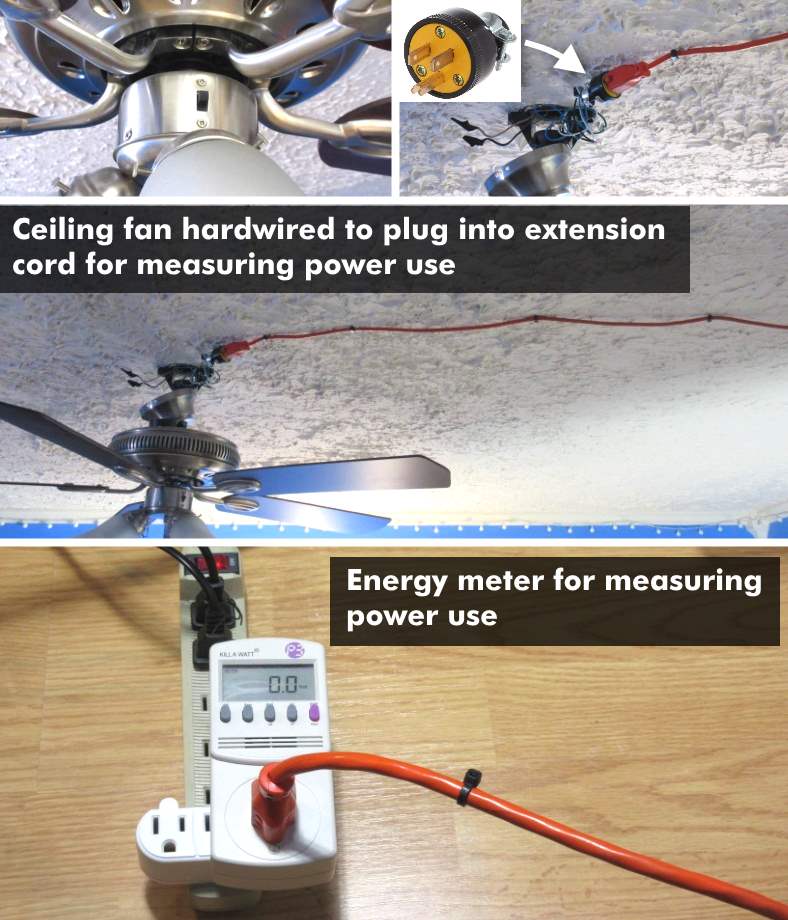
Shown: My quiz setup for measuring exactly how much electricity a ceiling buff uses. In say to get you the best information, I wanted to remove ANY guessing – thus I hardwired my 52″ ceiling fan to a power plug and connected it to my W. C. Handy Kill-A-Watt Department of Energy meter. I got great measurements and finally institute out what I couldn't find anywhere other!
Because I know that on that point's no substitute for men-on testing, to get a lineon the dot how much electricity a cap fan uses I hardwired my cap fan to work with an vigor meter.
What I've found is that the problem with many products like fans, air purifiers, and more is:
- Single theupper limit power use is listed in the spectacles (non the other numbers like for bass & intermediate speeds)
- DOE use measurements are often whole missing!
- Power employ numbers game are sometimes estimates,not what you'll in reality make it the real life
So, I definite to find out out conclusively. To do soh, I hardwired a 52 inch 3-amphetamine cap fan to an Actinium power outlet plug.
I then neighboring it to a high-quality extension cord and used my trusty Kill-A-Watt power habituate meter to measure the power use in watts.
How many watts does a ceiling fan use? My energy measurements
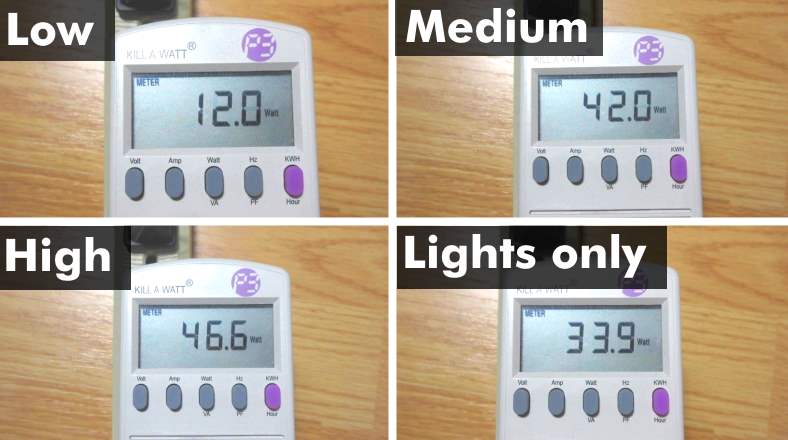
Measurements I made for ceiling lover electricity use, in Watts. I honestly expected a circumstances more power to cost used, but I was wrong! In fact,a ceiling fan laid to the pinched speed uses less electricity than many other fans that cost less. (Notice: When measuring only the lights be secondhand, the power use in watts was for three 15W LED bulbs)
IT was exciting to finallyput the question of how much electrical energy a ceiling fan uses to rest once and for all. I was so tired of not being able to find good info anywhere just like you.
Ceiling fan power (watts) measurement hold over
| Fan speed or mode | Power use (Isaac Watts) |
|---|---|
| Off | 0W |
| Humble | 12W |
| Average | 42W |
| High | 46.6W |
| Lights merely (3 x 15W Light-emitting diode bulbs) | 33.9W |
As you can see, even on the highest quicken (travel rapidly 3, or "soaring" when pulling the fan speed picker chain) I was really amazed to see that a standard, graduate-quality 52″ ceiling fan uses less than 50 watts of power.
Even more astounding was how little power combined uses when put away to the last-place speed: Only 12W! That's even less than many publicise purifiers and wee table fans I've well-tried.
Not bad at all!
How many amps does a cap rooter use?
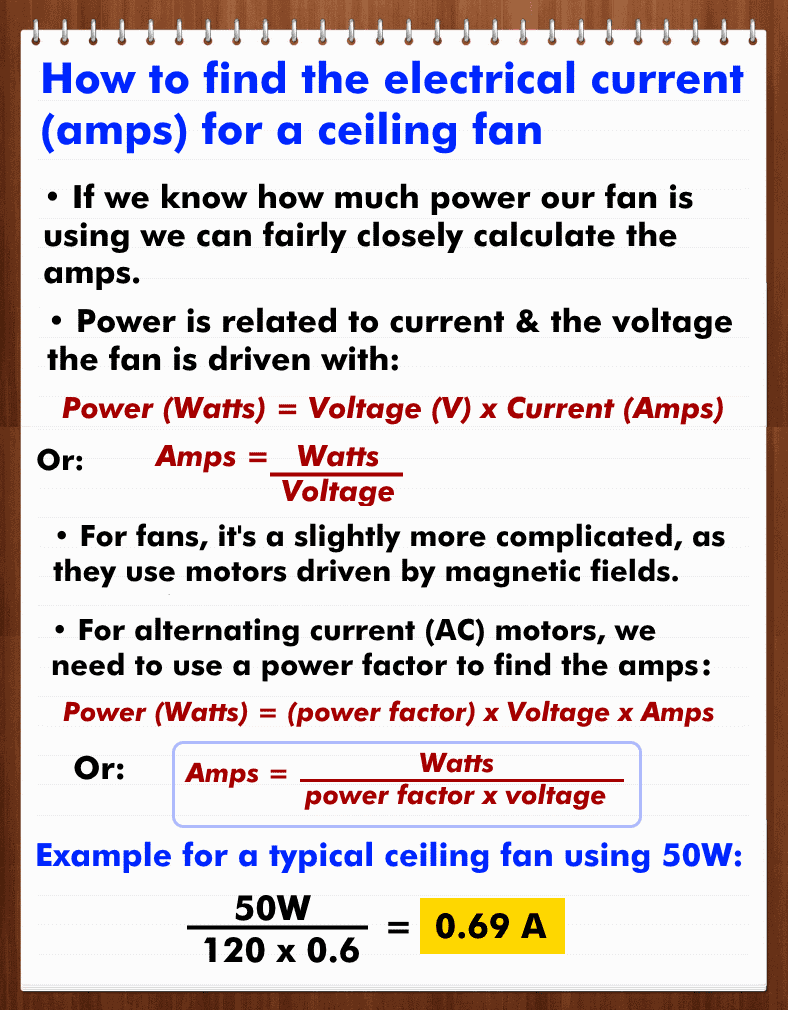
The introductory formula for how to calculate ceiling fan power use in Amperes (Amps, also written as "A"). To find out how many Amps a fan is victimization, we can easily get a somewhat accurate number if we know the business leader (Watts) and voltage it's using. Since fans are "a posteriori" motors, it gets slightly more complex, as we need to use a baron factory.
It's not hard to detect out how many a amps a ceiling buff uses. The most important thing is to know how much power, in Watts, the fan uses and the voltage it uses too. In most homes, that's around 120 volts (V).
However,since emblematic ceiling fans use an electric motor that works exploitation alternating latest (AC) and magnetic fields, it's just a bit more complicated.
Therein case, we need to know something called thebig businessman factor.
Greenbac: Several electrical testers tooshie measuring electrical occurrent and score information technology easy, assuming you've got a way to connect them inline with your fan. Others include the AMP used in the specs sheet Oregon label for the fan you own.
If not, we prat calculate IT on our have reasonably easily and get a relatively accurate number on our own in seconds!
Direct current (DC) fans vs AC (AC) fans
Some stylish fans use a high-efficiency design that changes the AC index in your national to DC power using electronics built into the fan.
However, all but sold today inactive use up a standard inductive motor. Because of that, they use magnetic Fields created by the AC voltage in your menage to go the fan motor.
In AC magnetic flux motors few electrical current is wasted and and so the motor draws more.
In this display case, we use a basic number to procreate and adjust for the extra amps the fan draws. This keep down is known as the power factor.
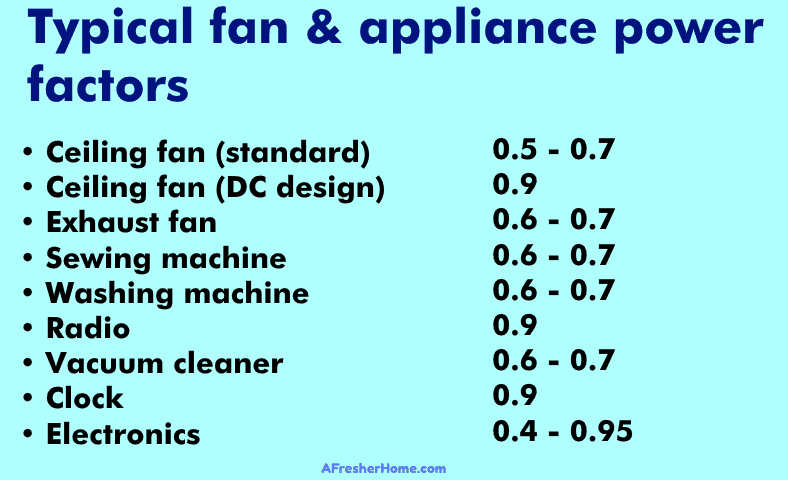
Power factors for many typical appliances including ceiling fans. The power factor in is a number that describes how much electric stream is haggard on attractable fields instead of power accustomed drive the motor. For instance, 1 = 100% efficiency, while a magnate factor of 0.5 agency an supererogatory 50% of current is needed.
In this example I'll use an example power factor value of 0.6. And so using our simpleton example:
Amps = power / (power element x voltage)
Here's are some typical numbers showing the amps used by a ceiling lover in my home.
Characteristic ceiling fan current draw (amps) at 120V:
| Fan speed or mode | Power (W) | Amps (A) |
|---|---|---|
| Off | 0A | 0A |
| Low | 12 | 0.17A |
| Medium | 42 | 0.58A |
| High | 46.6 | 0.65A |
Arsenic you can see, even on the highest speed a typical cap fan uses less than 1 adenosine monophosphate of current. That's a lot to a lesser degree you might expect! (Note: This prorogue shows the winnow used with the light bulbs turned disconnected)
As a matter of fact, that's a tiny fraction of what electrical devices like heaters use (they oftentimes use 10-20 amps or more).
These are rough numbers but most typical cap fans should Be very close too. Even if the voltage to your ceiling is a bit less than 120V AC, the results will still be in the ballpark as well.
Ceiling winnow vs AC comparison

As it turns out, cap fans use a tiny fraction of the electrical energy that broadcast conditioners (AC units) use. I premeditated the power draw of both to make over an honest, accurate graphical record comparing the ii so you can know what to expect.
Air conditioning (AC) units use alotmore power than a cap fan.
Why? It's because while electrical fans only need enough power to turn the causative that spins the blades, air conditioners need a lot of electrical power to driving force an electrically powered compressorin addition to an electrical fan inside.

Systematic to compare the two, I careful the power suck in Isaac Watts of both. For the air conditioner's power habit numbers racket, I measured the power draw of a standard in-window small room air conditioner just like you might buy for your rest home.
Ceiling rooter VS Alternating current superpowe use comparison shelve
| Fan speed/chilling mode | Ceiling fan baron | AC king |
|---|---|---|
| Off | 0W | 1.2W |
| Low | 12W | 365W |
| Medium | 42W | 373W |
| Piercing | 46.6W | 390W |
As you can check, a ceiling fan uses a tiny 12% of the power an air out conditioner does when set to high.
If you're wondering why the AC unit has 1.2W of ability use when it's turned off, it's because of the power required to keep memory settings like the endmost temperature you set and other features or controls.
For an air conditioner that uses lepton controls instead of mechanical controls, there are usually some circuits that need backup power even if it's non cooling a room, a good deal equivalent how a clock works.
What is an AC compressor you bet does air conditioner work out?
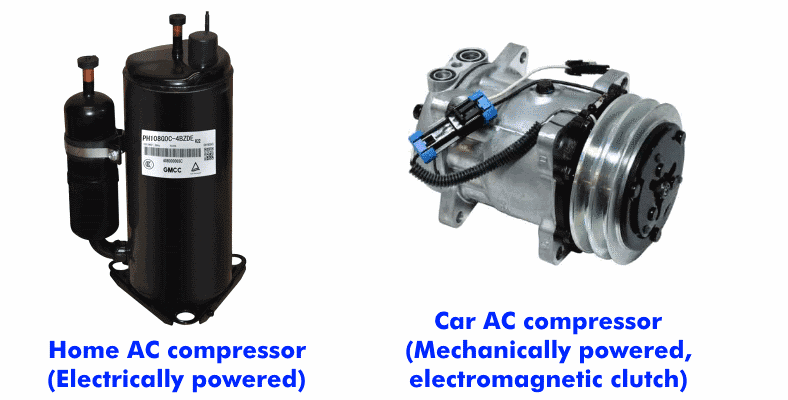
Left: A home AC unit's compressor which circulates refrigerant using an electric motor. Right: A car's AC compressor, driven by the engine and using a magnetic clutch to rotate the internal pistons when cooling is needed.
Strain conditioning compressors are a decisive part of an AC system, A cooling is made possible aside thermodynamics (adding or removing heat) properties that happen when a coolant gas is pressurized.
Systematic for an air conditioner to cool the air it must circulate refrigerant (normally named "freon") exploitation a pump so these pressure differences can happen.
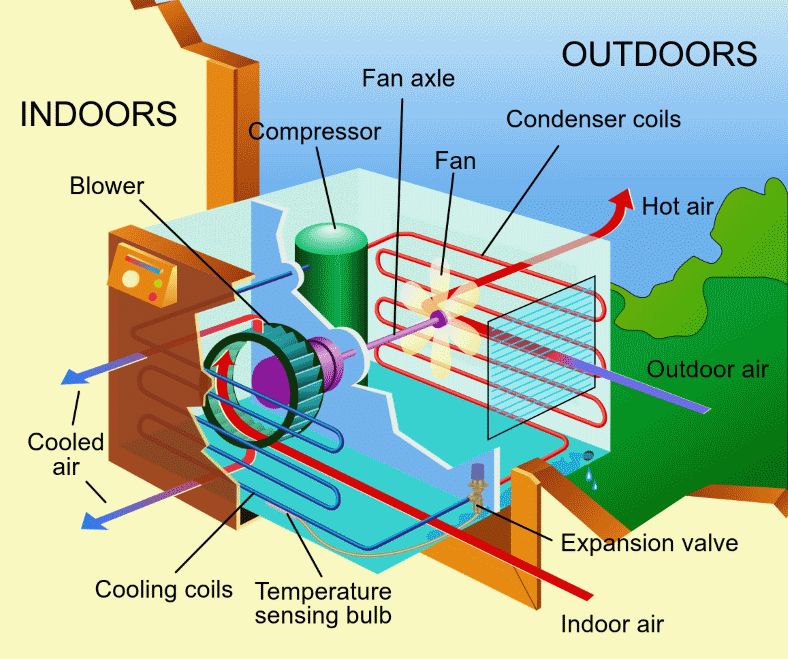
Aerial conditioners in your home (some window affixed and inner AC systems) contain a serial of hoses for circulating refrigerant. The compressor pumps the refrigerant, under pressure, which cools the air inside by removing estrus as a fan blows through it. The heat removed from the aviation inside is forced outside every bit it works.
Both at home and in your car this takes a lot of energy as the compressor requires a lot of force out to turn the pistons it inside it.
A compressor is a type of pump that moves refrigerant within a cooling system.
Because it's subordinate pressure (and because of the friction of its moving parts) this requires a draw of physical force out and more electrical power. When comparing a ceiling fan vs an Alternating current whole, formerly you understand the differences in what they do it's more clear why there's such a intense difference in business leader demands.
How do ceiling fans cool a room?

Ceiling fans and other types of fans puzzle out differently than AC systems. Rather of removing heat from the air travel contained in a elbow room they directly bungle air across your physical structure & surfaces which removes heat. This results in a cooling system gist.
Ceiling fans are much more efficient American Samoa they don't need the heavy wattage draw that Actinium units do. They work byforced broadcast convection cooling which means they blow air across surfaces and remove hot up as the air moves.
Cap fan vs knock down fan mogul use
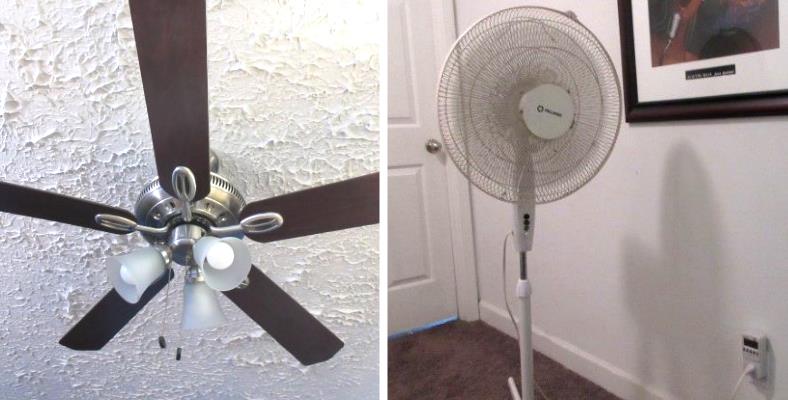
I measured the physical phenomenon power use of a classic 3-pep pill periodical floor fan. To boot, I measured power use some with and without the oscillating characteristic in use.
As it turns out therein case the floor fan secondhand the same amount regardless of oscillation.
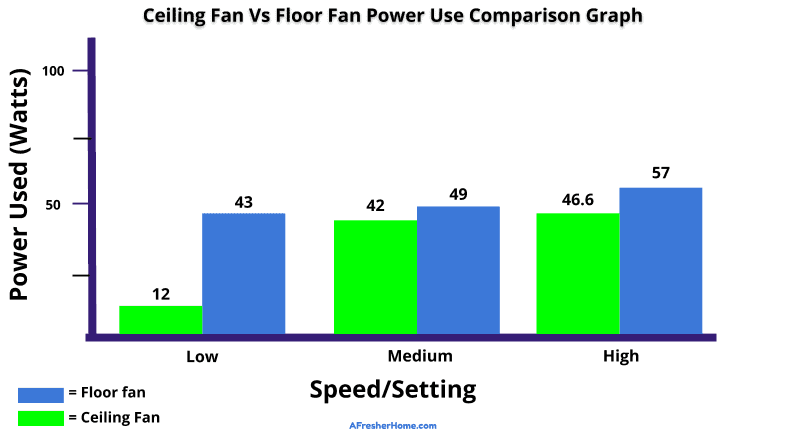
Graph screening how overmuch electrical energy a ceiling fan uses compared to a floor fan. Parenthesis from the lowest bucket along, they're very close in top executive use.
Cap fan VS ball over fan power measurements table
| Devotee speed | Ceiling winnow power | Flooring fan world power |
|---|---|---|
| Slay | 0W | 0W |
| Low | 12W | 43W |
| Medium | 42W | 49W |
| High | 46.6W | 57W |
Some have pros and cons. For example, a floor fan is good for very powerful airflow in only a lowly range. For about the same amount of energy use, however, a ceiling fan is better for cooling a room.
Tower fan vs cap fan power use

Comparing a Honeywell QuietSet 5-cannonball along tower fan to a ceiling fan is an gripping case. Note thatnot all tower fans use the same speeds American Samoa early brands and models.
In this case, I measured the might use of the 5-speed tower fan. As information technology's designed to be a quiet elbow room fan the fan speed International Relations and Security Network't American Samoa high as some others.
Since comparing 3 speeds to 5 isn't exactly still I classified the low and medium speeds to make it more clear.
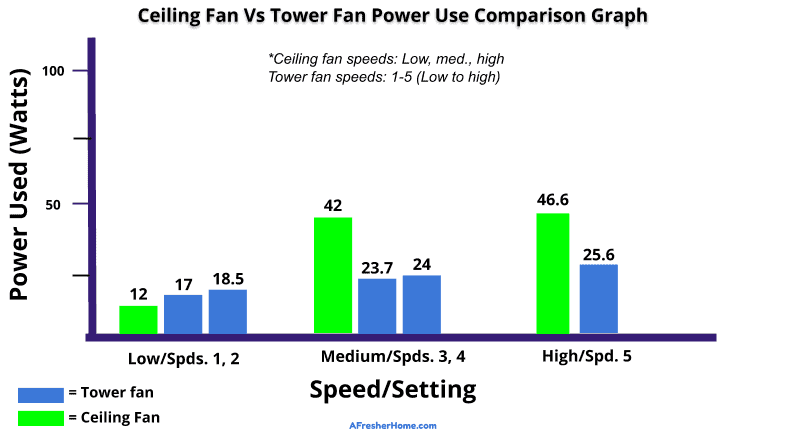
Ceiling winnow VS hul fan power measurements table
| Speed | Ceiling lover | Pillar lover |
|---|---|---|
| Off | 0W | 0W |
| Low | 12W | 17W, 18.5W |
| Master of Education. | 42W | 23.7W, 24W |
| High | 46.6W | 25.6W |
Promissory note: Measurements are with the tower fan's oscillation turned off. With it connected measurements were 19W, 20.8W, 26W, 26.3W, and 27.7W. This agency information technology adds 1-2W for oscillating motor powerfulness
As you can picture, a tower buff may use up a lot less power than a cap lover.
Some models like the Honeywell shown above are configured to work very quietly. Since the fan runs more quietly this affects how untold tycoo is used.
They'ray nice for quietly, gentle cooling in nonpareil specific direction piece sleeping.
Cap fans vs box fans

Loge fans are a favorite of mine because of how much white noise they can produce. That's one advantage they have over ceiling fans.
Like the other products in this post, I measured the power used by a characteristic boxful fan. What I found was interesting – they can use nigh twice as much energy as a ceiling winnow on the high setting.

Cap fan VS package fan power measurements table
| Speed | Ceiling fan | Box fan |
|---|---|---|
| Polish off | 0W | 0W |
| Low | 12W | 48W |
| Med. | 42W | 63.4W |
| High | 46.6W | 83W |
As you can see above, the disadvantage of a loge fan vs a ceiling fan is the extra energy use. Withal, for close to people they're a great choice especially if you have worry sleeping, or relaxing repayable to outside noises.
In that casing, the albumen noise they give rise is very helpful for block outside sounds while keeping you cool.
Ceiling fan vs table fan comparison
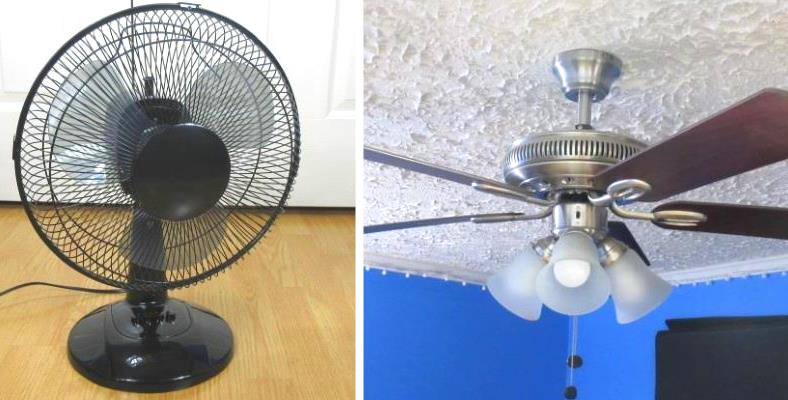
Table fans are yet other choice for chilling you and lowercase areas of a room. They're a great deal inexpensive simply unmoving crack an oscillation feature that turns the fan side to side while blowing air.
I was prying to see if they likewise offered any worthwhile energy use vs a ceiling devotee. Here's what I found when measurement a standard 12″ table devotee.
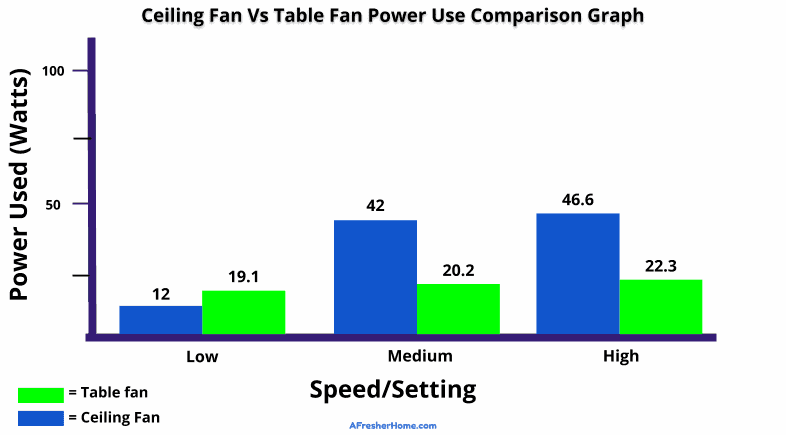
Cap devotee VS table fan power measurements mesa
| Speed | Ceiling fan | Box fan |
|---|---|---|
| Dispatch | 0W | 0W |
| Low | 12W | 19.1W |
| Med. | 42W | 20.2W |
| High | 46.6W | 22.3W |
Note: I made power measurements both with the table sports fan's oscillation feature onand off. The ability use was the same, which is great to love (I didn't list both above as it's no different).
As you can see, a table fan does use a lot less zip than a ceiling fan.
The tradeoff, however, is that they're only really useful for a lowly area such as dear your bed, near a desk, figure out table, and and then on.
They do also give a small sum of Theodore Harold White randomness which is nice. It's not every bit effective arsenic that from a loge fan, but it's worth considering.
However, over again if cooling the room is your end then a cap fan is still a better prime.
Cap fan wiring connections & wire discolor diagram

Click on the simulacrum to view the original/zoom or click below to download a copy
Ever wondered how hard IT is to connect a cap fan or how they get their power? As it turns taboo, they'Ra actually non very complicated in terms of wiring.
They'ray almost Eastern Samoa simple to wire ascending as light fixtures in your home. In fact, I've added new ceiling fans as you can install them in the place of a light fixture.
Umteen homes wealthy person metal boxes pre-installed in the ceiling where it's possible to find wiring ready to connect and mount a cap fan stand too if needed.
As you bottom see to it in the diagram I've provided, there are typically only most 4 wires needed for ceiling fan power connections.
Ceiling fan wiring colors & connections table
| Fan conducting wire color | Description |
|---|---|
| Angry | 120V power "hot" wire for the rooter motor racing circuit. Connects to home's black (lucky) wire |
| Whiteness | Electroneutral power return electrify. Connects to Theodore Harold White neutral (return power) telegram |
| Blue | Fan light circuit power. Connects to the black supply wire |
| Green / Lt green | If present (or another color), connects to the place's ground wire. Some fans also own a priming telegram along the mounting base to connect. |
Ultimately it depends happening the particular fan so remember the wiring colors listed here are just examples of my own. Always double-check the installation instructions to be sure.
In my case, the ground wire had its own label related to.
Why does my cap fan hum?
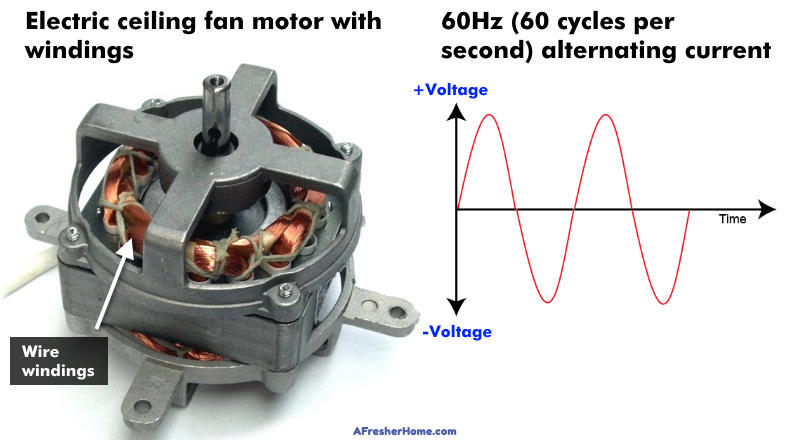
Galvanic fan motors contain a huge amount of copper wire windings inside. These windings create magnetic fields that turn the fan rotor (the primal rotating start inside the motor) and spin the fan blades. Alternating flow (AC) from your home's electrical plant changes management constantly at 60 times per second (60 Hertz per second) and can stimulate a humming sound.
Electric fans of many kinds, including cap fans, are subject to a temperate hum sound you may notice.
Information technology's a very common fallout of the typewrite of electrical powerfulness supply that homes use. As time goes by it can actually increase in volume as a fan and its parts historic period. That's because the tiny vibrations move components terminated clip and parts can lose the resistance to vibration they had when parvenu.
AC power is in the range of frail hearing
The 60 Hertz (Hz) frequency for the alternating current (Alternating current) baron supply in your home is within the range of sound your ears can find out. In fact, AC current produces a "hum" healthy in the range of bass you sometimes hear in medicine.
It's especially democratic in fans like box fans. They're more than prostrate to vibrating and much likely to create a humming sound that's easy to hear.
In some situations, the fan's hum vibration due to the exponent origin can transfer through surrounding cap parts and the secure can carry further, making it even more marked.
Galvanising motors &adenosine monophosphate; attractable fields
Electric motors rely on magnetic fields created when electricity flows through copper telegram windings. This creates a magnetic thrust that turns the central part of the motor called a rotor coil.
The rotor is attached to a mandril that the fan blades are mounted on and birl from at that place.
These magnetic fields, which switch direction 60 multiplication per instant, can cause fan parts to strike rapidly and thus create a humming sound your ears can get a line.
It's also why when you're close to outdoor business leader transformers used by the power troupe (or other electrical devices) you may hear a hum there also.
In summary

To summarize the electrical magnate use and pros & cons of ceiling fans, Army of the Pure's review what I've covered present today.
Eastern Samoa you put up go through from the power utilise I careful, they'revery reasonable in how much electricity they use. That'sespecially true when compared to how much an AC unit uses!
They do have pros and cons though, of course. While they're good for cooling a altogether way (and give for themselves in only a couple of months as compared to melodic line conditioners) they aren't good for white noise OR for cooling an exact area of you or your room.
Overall, however, they'Ra a great prime.
Suggestions for even more mogul nest egg

To keep energy costs squat and still get good quality lighting, choose an energy-prompt LED bulb with good brightness output level (measured in Lumens).
For best results, I recommend using good prime LED bulbs that produce light that's easy on your eyes. These years you can find commanding-brightness LED bulbs that wreak well in cap fans and take in 15W or less.
Compared to the magnate use of glorious bulbs of old age gone by (45W, 60W, and even 100W) that's acolossal vigour saving!
Brightness and light quality matters
Many pass some choices of color "temperature" (the yellowish or white shade they produce) and smartness. I recommend getting bulbs with enough brightness, measured in Lumens.
Personally, I recommend bulbs with a lumens military rating of 800 or higher, although you can receive some putt taboo 1,200 or smooth 1,500 with only 15W power use if you shop carefully.
These days favourable LED bulbs can be found for more or less $3-$10 each or in bulk quantities for even more nest egg. Avoid the inalienable cheapest bulbs as they have higher failure rates and lean to have a poor light quality that International Relations and Security Network't good for your eyes.
Gaudy bulbs also have poor color rendering which means that colors won't look lifelike or appear too as they should.
Additive reading
Considering a box winnow or else of a ceiling lover because you need white noise? Have a facial expression at my great post with some of the best box fans for white noise here.
Need a quiet, gentle tower fan that North Korean won't disturb you? Here's a helpful inclination of close to of the best tower fans for cooling.
Do Ceiling Fans Use a Lot of Electricity
Source: https://afresherhome.com/how-much-electricity-ceiling-fan-use-guide/

0 Comments